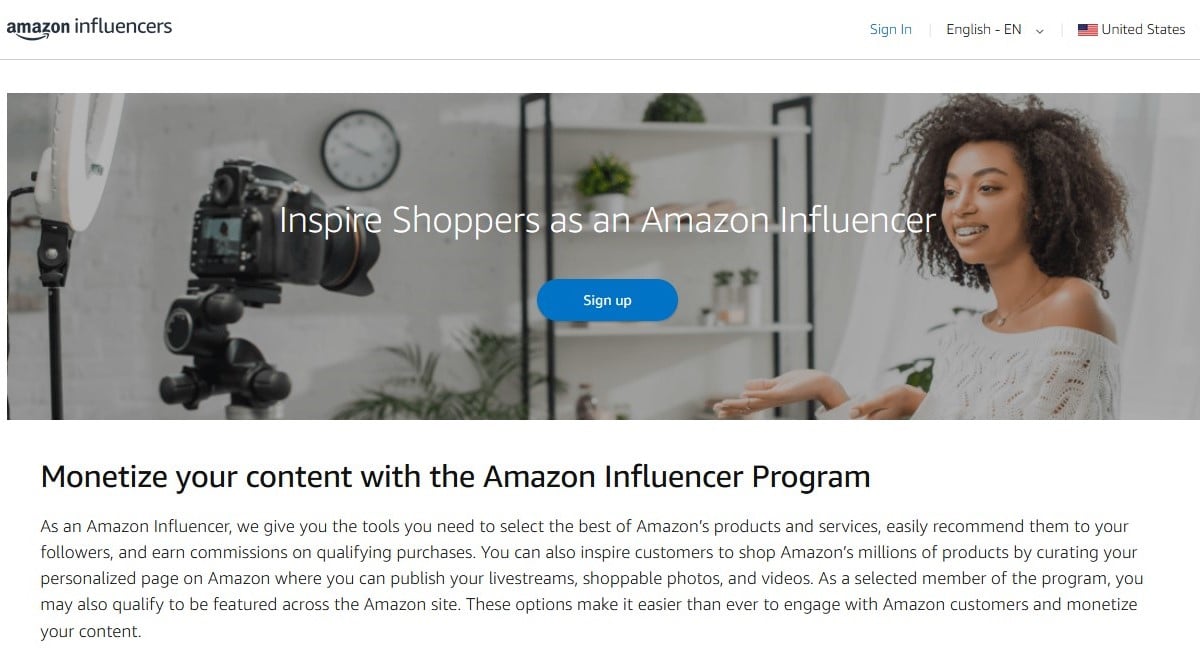You want to monetize recommendations, but two Amazon programs can make that decision feel like a fork in the road. Both let you earn when people buy through your links, but they’re built for different kinds of creators, habits, and workflows. Below I’ll walk you through the real differences between Amazon influencer and Associates— eligibility, how commissions work, and what creating content looks like for each — so you can pick the one that actually fits your audience and the way you like to work.
How they differ at a glance
Amazon Associates is broad. It’s meant for publishers: bloggers, websites, apps, and social media accounts who can insert product links anywhere.
Amazon Influencer is a narrower, social-first path. It gives approved creators a customizable Amazon storefront and tools tailored to social audiences.
Commissions are similar in idea but vary by product category and sometimes by program nuances. The base commission rates (which vary by product category) are the same for the standard off-site links in both programs. However, Amazon Influencers can earn additional commissions (often at different rates) for approved on-site content, such as videos that appear on Amazon product pages. Keep reading.
Check these 4 affiliate pitfalls that kill earnings for Amazon Associates.
Who can join: eligibility and what Amazon looks for
Amazon Associates (the classic affiliate program)

You can join if you have a website, app, YouTube channel, or other content platform where you can publish links. Amazon reviews your application and wants to see original content and a clear audience — it’s not purely about follower numbers, but about whether your platform looks real and active. Expect to show your site or channel during sign up.
Crucially, full acceptance requires you to generate at least three qualifying sales within the first 180 days. If you’re running a niche blog, a review site, or a resource page, this is the usual entry point for most people who monetize content online.
Amazon Influencer (social creators)
This one is built for people who already have a social presence. Amazon evaluates your social channels — they look at follower counts, yes, but engagement and content quality matter, too. You don’t need millions; micro-influencers with engaged audiences can and do get accepted. But it’s still a selective gate.
If most of your traffic lives on Instagram, TikTok, or a well-followed YouTube channel and you prefer sharing curated picks rather than embedding links in long blog posts, this program is designed for you.
So which is harder to get into? Influencer tends to feel more subjective because of the social review; Associates is more mechanical (platform + content) but still expects a legitimate presence and the fulfillment of the initial sales requirement.
How you earn: commission structure and payout basics
Let’s keep this simple.
- Both programs pay commission based primarily on product category. Rates vary — some categories pay higher percentages, others are lower. Both programs use Amazon’s associate rates table as the foundation, but promotions and updates can shift percentages over time.
- Associates is very flexible: you create links to individual products, get credit for qualifying purchases in that session, and earn commissions on the order. If someone clicks your link and adds other items, you often earn from those too.
- Influencer funnels traffic through a storefront or individual links. That storefront is powerful: it’s a persistent, branded page on Amazon with your recommended items, which you can link to from social bios. People who land there and buy can generate commissions just like with Associates. Additionally, the Influencer program provides a special opportunity to earn commissions when your original video content is approved for use on Amazon’s product pages (referred to as “On-Site” commissions). These On-Site rates are often higher than the standard off-site rates for certain product categories.
A practical difference: Influencer storefronts can convert better for social audiences because they reduce friction. Your followers click your bio link and see a curated, shoppable list. No hunting required. That can lift conversion rates, which matters more than a tiny difference in percentage points.
Payouts follow Amazon’s usual cadence and rules. Expect thresholds and reporting through Amazon’s affiliate dashboards.
Content creation and workflow: what you’ll actually do day to day
This is where the two programs diverge most in practice.
If you join Amazon Associates
- You’ll place product links inside articles, review posts, comparison pages, or video descriptions.
- SEO matters. Long-form content that ranks will compound earnings over time.
- You’ll probably use product pages, widgets, and native shopping ads. Tools are flexible but require you to think about placement, anchor text, and on-page intent.
- It’s great if you enjoy research, deep reviews, or building evergreen content that keeps earning months down the line.
If you join Amazon Influencer
- Your content is social-first: short videos, stories, reels, swipe-ups, or single-image posts plus a link to your storefront.
- Visuals and personality matter. Quick unboxings, short demos, and “here’s what I use” posts work well.
- You get a storefront that’s always there — so you can promote it once and keep getting clicks. You also have the opportunity to submit original content (like product review videos) to Amazon to be placed on product pages, which can earn you additional On-Site commissions.
- It’s ideal if you want a low-friction referral path for followers who aren’t clicking blog links, or if you prefer producing short-form content over long reviews.
Which workload is lighter? Tough to generalize. Influencer can be lower friction per referral — one bio link, many posts — but it demands frequent visual content and real-time engagement and the creation of on-site content to maximize earnings. Associates requires more writing and SEO effort, but those pages can become passive income machines.
Practical differences that matter to you
- Branding and permanence: Influencer storefront feels more branded and persistent. Your storefront is a place followers return to. Associates links live where you put them — a blog post, a review — and are as permanent as that post.
- Link flexibility: Associates gives more granular control (single-product deep links, API options, widgets). Influencer is friendlier for social sharing but a bit less granular for certain technical setups.
- Audience fit: If your traffic is mostly social, influencer storefronts convert better. If your traffic comes from search and long-form content, Associates is usually the smarter match.
- Approval process: Influencer acceptance depends on social signals. Associates looks at the presence and content quality of your site or channel but also requires three qualifying sales within 180 days for final approval.
- Metrics and attribution: Both provide dashboards. Associates historically has richer linking tools for sites, whereas Influencer emphasizes storefront and social-friendly reporting plus additional reporting for On-Site content performance.
Edge cases and combos: can you use both?
Yes. Many creators do both. Use Associates on your blog and the Influencer storefront on your social profiles. That way you capture search-driven buyers and social followers, simultaneously. Just be mindful of Amazon’s policies around link disclosure and placement; you still need to follow the rules for each program.
Pros and cons — a fast checklist
Amazon Associates
- Pros: Great for blogs and long-form content; detailed link tools; strong for SEO-driven, evergreen revenue.
- Cons: Requires more written or long-form output; links can get lost in dated posts unless you update them; requires 3 qualifying sales in 180 days for final approval.
Amazon Influencer

- Pros: Built for social content; storefront reduces friction; good for personality-driven recommendations; offers the potential for On-Site commissions.
- Cons: Acceptance is selective; success needs steady social content and engagement.
How to choose: a short decision guide
Ask yourself three questions:
- Where is most of your audience right now — search or social?
- Which content do you enjoy making — long reviews or short, visual posts (including videos for Amazon product pages)?
- Do you want a branded storefront that’s always there, or do you prefer placing links where they fit in an article?
If your answer skews toward search, long-form, and SEO: start with Amazon Associates.
If your audience lives on social, you like short visual content, and you want a single, shoppable link for followers: aim for the Amazon Influencer Program.
If you can do both, do both. It’s not exclusive and often becomes the best long-term strategy.
Final thoughts — not everything is black and white
There’s no perfect pick that fits every creator. Your best move is to align program choice with where your audience already spends time and how you like to create. If you chase the latest trend rather than your strengths, you’ll probably burn out or underperform. But if you lean into what you do well — and test a couple of formats — you’ll learn fast which channel and program reward your effort. Decide, test, and iterate. That old three-step still works.
If you found this useful — or if you have a specific situation (a small niche blog, a budding TikTok, or a long-running YouTube channel) drop a comment below and tell us which platform you use. I’ll respond with tailored ideas. Also, follow us on Facebook, Twitter, and Pinterest to catch quick tips and real case studies that show what actually pays off.
Do you want to broaden your online income? Here are 9 realistic online side jobs you can start today.

Hello folk,
I’m here to provide you with tips, tricks, and guidance on how to join affiliate programs and monetize your sites or social media accounts. On the right of the site, you can find a list of categories. Just click on those that interest you and see the affiliate programs available. Join those that fit with your writing expertise and your target audience. If you like my posts, please give me a like here:
Facebook, X (Twitter), Instagram, Pinterest, Website, Contact us



[…] Amazon Influencer vs. Amazon Associate: discover which program is right for you. […]